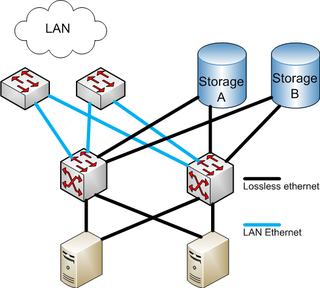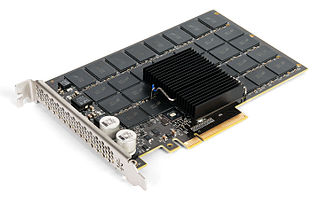Darwin is an open-source Unix-like operating system first released by Apple Inc. in 2000. It is composed of code derived from NeXTSTEP, BSD, Mach, and other free software projects' code, as well as code developed by Apple.
DECnet is a suite of network protocols created by Digital Equipment Corporation. Originally released in 1975 in order to connect two PDP-11 minicomputers, it evolved into one of the first peer-to-peer network architectures, thus transforming DEC into a networking powerhouse in the 1980s. Initially built with three layers, it later (1982) evolved into a seven-layer OSI-compliant networking protocol.

InfiniBand (IB) is a computer networking communications standard used in high-performance computing that features very high throughput and very low latency. It is used for data interconnect both among and within computers. InfiniBand is also used as either a direct or switched interconnect between servers and storage systems, as well as an interconnect between storage systems. It is designed to be scalable and uses a switched fabric network topology. By 2014, it was the most commonly used interconnect in the TOP500 list of supercomputers, until about 2016.

Serial ATA is a computer bus interface that connects host bus adapters to mass storage devices such as hard disk drives, optical drives, and solid-state drives. Serial ATA succeeded the earlier Parallel ATA (PATA) standard to become the predominant interface for storage devices.

A network interface controller is a computer hardware component that connects a computer to a computer network.

In computer networking, link aggregation is the combining of multiple network connections in parallel by any of several methods, in order to increase throughput beyond what a single connection could sustain, to provide redundancy in case one of the links should fail, or both. A link aggregation group (LAG) is the combined collection of physical ports.
ATA over Ethernet (AoE) is a network protocol developed by the Brantley Coile Company, designed for simple, high-performance access of block storage devices over Ethernet networks. It is used to build storage area networks (SANs) with low-cost, standard technologies.
In audio and broadcast engineering, Audio over Ethernet is the use of an Ethernet-based network to distribute real-time digital audio. AoE replaces bulky snake cables or audio-specific installed low-voltage wiring with standard network structured cabling in a facility. AoE provides a reliable backbone for any audio application, such as for large-scale sound reinforcement in stadiums, airports and convention centers, multiple studios or stages.

Linux is an open-source Unix-like operating system based on the Linux kernel, an operating system kernel first released on September 17, 1991, by Linus Torvalds. Linux is typically packaged as a Linux distribution.

A solid-state drive (SSD) is a solid-state storage device that uses integrated circuit assemblies to store data persistently, typically using flash memory, and functioning as secondary storage in the hierarchy of computer storage. It is also sometimes called a semiconductor storage device, a solid-state device or a solid-state disk, even though SSDs lack the physical spinning disks and movable read–write heads used in hard disk drives (HDDs) and floppy disks. SSD also has rich internal parallelism for data processing.

VMware ESXi is an enterprise-class, type-1 hypervisor developed by VMware for deploying and serving virtual computers. As a type-1 hypervisor, ESXi is not a software application that is installed on an operating system (OS); instead, it includes and integrates vital OS components, such as a kernel.
The SC101 was a home computer networking storage product manufactured and distributed by Netgear under the Storage Central brand from around 2005 through 2010. The devices shared data stored on one or two internal disks via Ethernet links.
Z-SAN is a proprietary type of storage area network licensed by Zetera corporation. Z-SAN hardware is bundled with a modified version of SAN-FS, which is a shared disk file system driver and management software product SAN File System (SFS) made by DataPlow. The shared disk file system allows multiple computers to access the same volume at block level. Zetera calls their version of the file system Z-SAN.

Fibre Channel over Ethernet (FCoE) is a computer network technology that encapsulates Fibre Channel frames over Ethernet networks. This allows Fibre Channel to use 10 Gigabit Ethernet networks while preserving the Fibre Channel protocol. The specification was part of the International Committee for Information Technology Standards T11 FC-BB-5 standard published in 2009.

The Vortex86 is a computing system-on-a-chip (SoC) based on a core compatible with the x86 microprocessor family. It is produced by DM&P Electronics, but originated with Rise Technology.

Fusion-io, Inc. was a computer hardware and software systems company based in Cottonwood Heights, Utah, that designed and manufactured products using flash memory technology. The Fusion ioMemory was marketed for applications such as databases, virtualization, cloud computing, big data. Their ioDrive product was considered around 2011 to be one of the fastest storage devices on the market.

Coraid, Inc. is a computer data storage vendor that provides storage area network (SAN) products that use Ethernet, headquartered in Athens, Georgia.
DNOS or Dell Networking Operating System is a network operating system running on switches from Dell Networking. It is derived from either the PowerConnect OS or Force10 OS/FTOS and will be made available for the 10G and faster Dell Networking S-series switches, the Z-series 40G core switches and DNOS6 is available for the N-series switches.
Distributed Overlay Virtual Ethernet (DOVE) is a tunneling and virtualization technology for computer networks, created and backed by IBM. DOVE allows creation of network virtualization layers for deploying, controlling, and managing multiple independent and isolated network applications over a shared physical network infrastructure.











